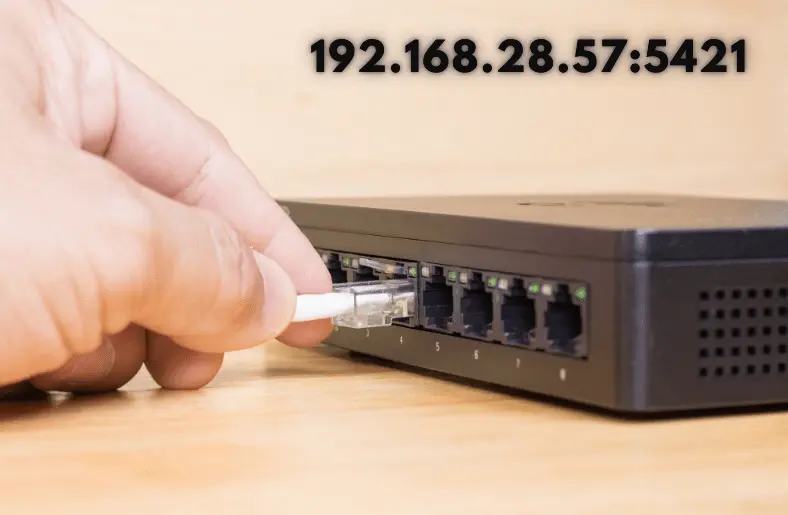Delving into the realm of computer networking, we encounter a unique address: 192.168.28.57:5421. This seemingly cryptic combination holds significant meaning within the intricate tapestry of network communication. Subsequently, we will dissect this address, exploring its components and unraveling its purpose. Moreover, we will delve into its practical applications, illuminating its role in various networking scenarios. Finally, we will emphasize the importance of security measures to safeguard this crucial aspect of network infrastructure.
Understanding the Components
Firstly, let’s dissect the address. 192.168.28.57 is a private IP address. Notably, private networks utilize these addresses, ensuring enhanced security. In contrast, public IP addresses are visible on the internet. Moving forward, we encounter “:5421,” representing a port number. Importantly, port numbers act as gateways for different applications within a network. Furthermore, port 5421 is often designated for custom applications, enabling specialized communication channels.
How 192.168.28.57:5421 Works
Firstly, within a local network, this address facilitates seamless communication. Subsequently, data traverses the network, guided by the IP address to the designated device. Concurrently, the port number directs the data to the precise application or service residing on that device. Therefore, a harmonious interplay exists between the IP address and the port number, ensuring accurate data delivery.
Moreover, let’s explore some illustrative scenarios. For instance, accessing a network printer often involves utilizing a similar address format. Furthermore, managing smart home devices, such as security cameras or thermostats, frequently relies on this type of address structure.
Common Uses and Applications
- Remote Device Management: Facilitates remote control of servers, routers, and other network devices, improving efficiency and simplifying maintenance.
- Accessing Network Devices: Enables seamless access to peripherals like printers, scanners, and storage devices connected within the local network.
- IoT Device Communication: Underpins the communication and control of smart home devices, such as thermostats, security systems, and lighting.
- Custom Software and Applications: Supports the function of specialized applications within a network, tailored to specific organizational needs.
- Home Networking: Essential for the interconnectivity and management of devices within a home network, including smart home appliances and entertainment systems.
Table Explanation
| Table | Explanation |
| Remote Device Management | Enables administrators to manage network devices remotely, enhancing efficiency and reducing downtime. |
| Accessing Network Devices | Facilitates access to and control of peripheral devices like printers, scanners, and storage drives connected to the network. |
| IoT Device Communication | Essential for the seamless operation and control of Internet of Things devices, such as smart home appliances and sensors. |
| Custom Software and Applications | Supports the operation of internal applications and services within an organization’s network infrastructure. |
| Home Networking and Smart Home Devices | Facilitates the connection and management of smart home devices, enabling convenient control and automation within a home environment. |
Security Considerations
- Importance of Network Security: Network security is paramount to safeguard data, prevent unauthorized access, and maintain the integrity of network operations.
- Firewall Rules and Configurations: Firewalls act as a crucial defense, meticulously controlling network traffic by enforcing security rules and filtering out malicious activity.
- Strong Passwords and Authentication: Employing robust passwords and multi-factor authentication significantly enhances security by deterring unauthorized access attempts.
- Encryption of Network Traffic: Encrypting data transmitted over the network safeguards sensitive information from interception and unauthorized access.
- Regular Security Audits and Updates: Conducting regular security assessments and promptly applying software updates are essential to identify and mitigate potential vulnerabilities.
Table Explanation
| Security Consideration | Explanation |
| Importance of Network Security | Safeguards data, prevents unauthorized access, and maintains the integrity of network operations. |
| Firewall Rules and Configurations | Controls network traffic, filters malicious activity, and enhances overall network security posture. |
| Strong Passwords and Authentication | Enhances security by deterring unauthorized access through the use of robust passwords and multi-factor authentication. |
| Encryption of Network Traffic | Protects sensitive data from interception and unauthorized access by encrypting data transmitted over the network. |
| Regular Security Audits and Updates | Identifies and mitigates potential vulnerabilities by conducting regular security assessments and promptly applying software updates. |
Troubleshooting Common Issues
Firstly, IP address conflicts can disrupt network communication. If multiple devices on the network are assigned the same IP address, confusion and connectivity issues can arise. Secondly, firewalls, while crucial for security, may inadvertently block traffic destined for the specified port. This can occur if the firewall rules are not configured correctly. Moreover, service downtime or unavailability can significantly impact network functionality. If the service running on the designated port is not operational, communication will be disrupted.
Furthermore, network congestion can lead to performance degradation. Excessive network traffic can slow down data transmission and increase latency, impacting the speed and reliability of communication. Finally, incorrect device or network configurations can cause a range of problems, from connectivity issues to intermittent service disruptions. Ensuring accurate and up-to-date configurations is crucial for smooth network operation.
Conclusion
In conclusion, understanding the intricacies of “192.168.28.57:5421” is pivotal for navigating the complexities of local network communication. Subsequently, by grasping the fundamental concepts of IP addresses, port numbers, and their interplay, individuals can effectively troubleshoot network issues and optimize network performance. Moreover, implementing robust security measures is paramount to safeguard network integrity and ensure seamless operation.
FAQ’s
- What is the significance of 192.168.28.57:5421?
This unique combination identifies a specific device and service within your local network.
- Can I access this address from the internet?
No, this address is designated for private networks and is not accessible from the public internet.
- How can I troubleshoot connectivity issues?
Verify network connections, check firewall settings, and ensure the service is running.
- What is the role of port 5421?
Port 5421 typically serves as a gateway for custom applications or services within the network.
- Why is 192.168.28.57:5421 considered a private IP address?
This IP address falls within the 192.168.x.x range, specifically reserved for private networks.



